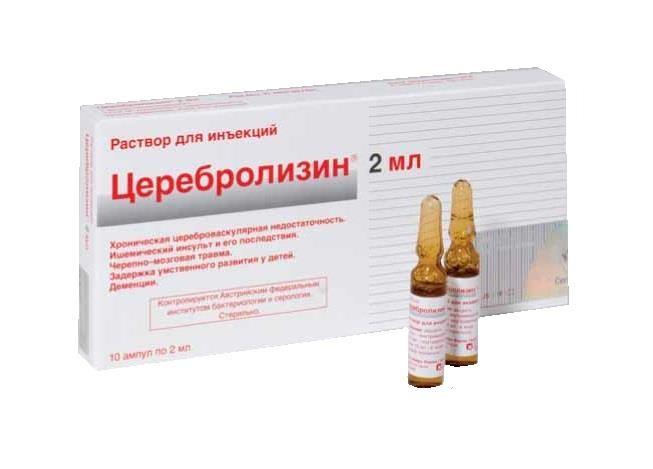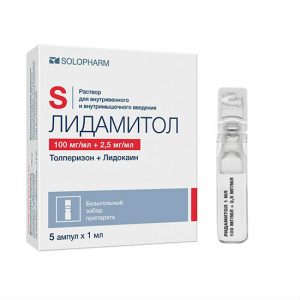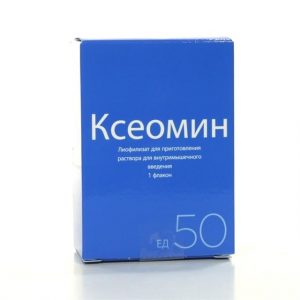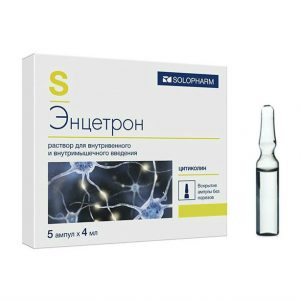Description
Latin name
Cerebrolysin
Packing
10 ampoules of 2 ml.
Indications
Alzheimer’s disease
dementia syndrome of various origins
chronic cerebrovascular insufficiency
ischemic stroke
traumatic brain injury and spinal cord
delayed mental development in children with attention-deficit and high-grade treatment
Contraindications
individual intolerance to the drug
acute renal failure
status epilepticus.
Use during pregnancy and lactation
With caution, the drug is prescribed in the first trimester of pregnancy and during lactation.
During pregnancy and during breastfeeding, Cerebrolysin should be used only after a thorough analysis of the relationship between the positive effect of treatment and the risk associated with its implementation. The results of experimental studies do not give reason to believe that Cerebrolysin has a teratogenic effect or has a toxic effect on the fetus. However, no similar clinical studies have been conducted.
Composition of
1 ml of injection contains: active substance: cerebrolysin concentrate (a complex of peptides obtained from the pig brain) 215.2 mg,
excipients: sodium hydroxide water for injection
Dosage and administration
Intramuscularly (up to 5 ml), intravenously (up to 10 ml), intravenously, by slow infusion (from 10 to 50 ml).
Doses and duration of treatment depend on the nature and severity of the disease, as well as on the age of the patient. It is possible to prescribe single doses, the value of which can reach 50 ml, however, it is more preferable to conduct a course of treatment. The recommended optimal course of treatment is daily injections for 10 20 days.
Acute conditions (ischemic stroke, head injury, complications after neurosurgical operations) – from 10 to 50 ml.
The residual period of stroke and traumatic damage to the brain and spinal cord is from 5 to 50 ml.
Psycho-organic syndrome and depression – from 5 to 30 ml.
Alzheimer’s disease, dementia of vascular and combined Alzheimer’s vascular origin – from 5 to 30 ml.
In neuropediatric practice – 0.1-0.2 ml / kg.
To increase the effectiveness of treatment, repeated courses may be carried out until an improvement in the patient’s condition due to treatment is observed. After the first course, the frequency of administration of doses can be reduced to 2 or 3 times a week.
Doses of 10 to 50 ml are recommended to be administered only by slow intravenous infusion after dilution with the proposed standard solutions for infusion. The duration of infusion is from 15 to 60 minutes.
Side effects
Reaction to administration: if administered too quickly, in rare cases it may cause fever, sweating, dizziness in isolated cases – a rapid heartbeat or arrhythmias. Therefore, the drug should be administered slowly.
From the gastrointestinal tract: rarely – loss of appetite, dyspepsia, diarrhea, constipation, nausea and vomiting.
From the side of the central nervous system and peripheral nervous system: in rare cases, the expected activation effect was accompanied by excitement (manifested aggressive behavior, confusion, insomnia). There are reports of occurrence in isolated cases (
On the part of the immune system: extremely rarely – hypersensitivity reactions or allergic reactions, manifested by headache, pain in the neck, limbs, lower back, shortness of breath, chills and collapsoid state.
Local reactions: rarely – redness of the skin, itching and burning at the injection site
Other: extremely rare – according to the results of studies, cases of hyperventilation, arterial hypertension, arterial hypotension, fatigue, tremor, depression, apathy, dizziness, and flu-like symptoms (cough, runny nose, respiratory tract infection)
that some undesirable effects (agitation, arterial hypertension, arterial hypotension, lethargy, tremor, depression, apathy, dizziness, headache, shortness of breath, diarrhea, nausea) were detected during clinical trials and occurred equally in patients receiving cerebrolysin, and in placebo patients.
Drug Interaction
Given the pharmacological profile of Cerebrolysin, particular attention should be paid to possible additive effects when co-administered with antidepressants, incl. MAO inhibitors. In such cases, it is recommended to reduce the dose of the antidepressant.
Do not mix in one solution for infusion Cerebrolysin and balanced amino acid solutions.
Cerebrolysin is incompatible with solutions containing lipids and with pH-changing solutions (5 8).
Storage Conditions
The product should be stored in a dark place at a temperature not exceeding 25 ° C.
Shelf life
5 years.
dosage form
injection
Possible product names
CEREBROLYSIN 2ML N10 AMP R-D D / IN
Cerebrolysin 2ml r-r d / in. Amp. X10 B M (R)
Cerebrolysin ampoules, 2 ml, 10 pcs.
CEREBROLYSIN R-D D / IN. 2ML No. 10
Cerebrolysin solution d / in. amp. 2ml N10 Austria




